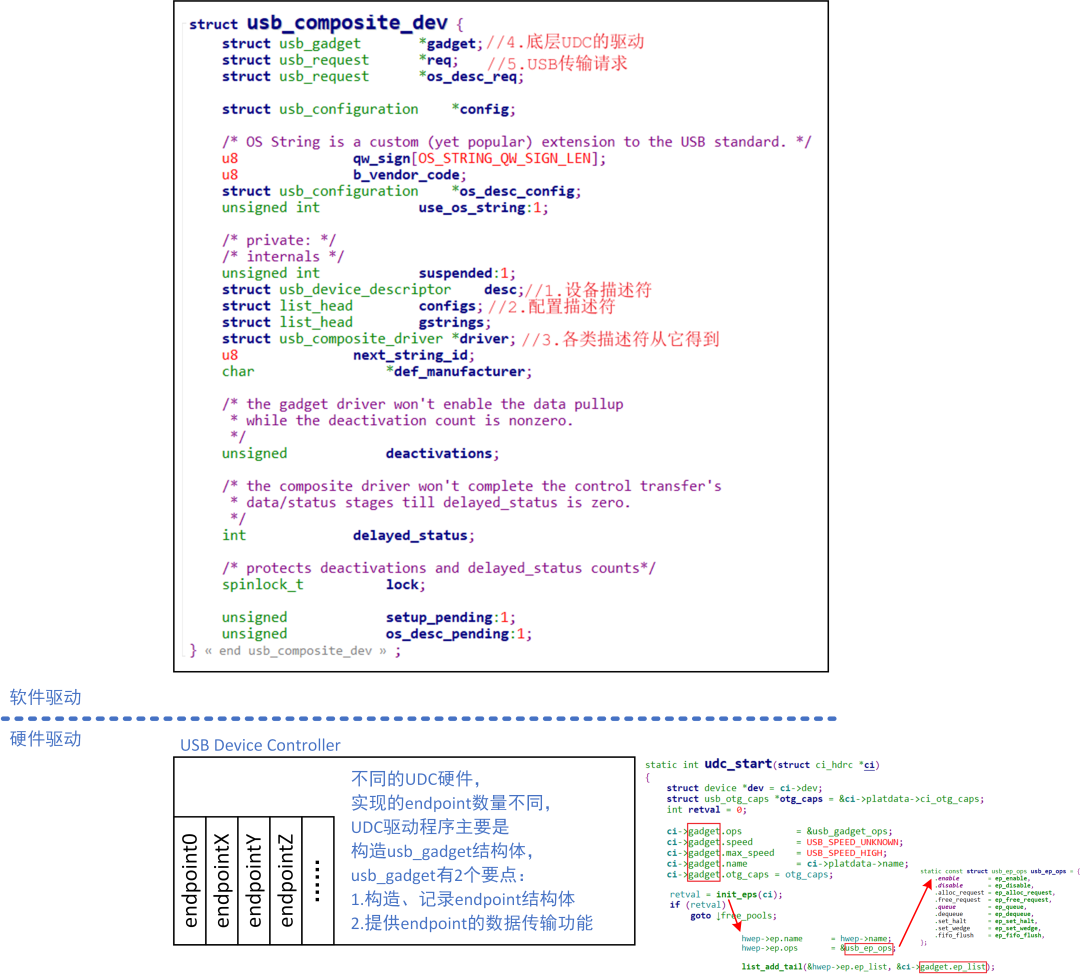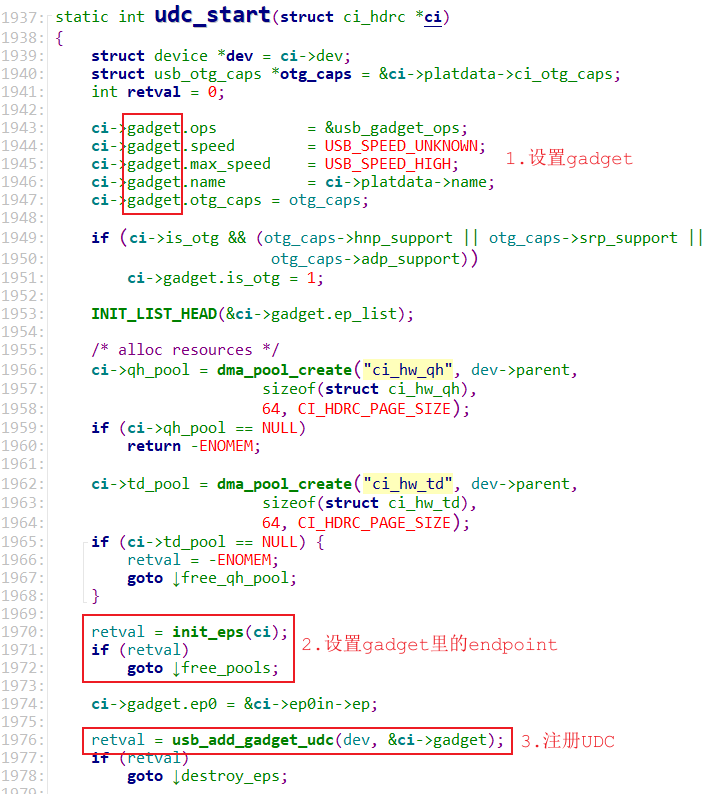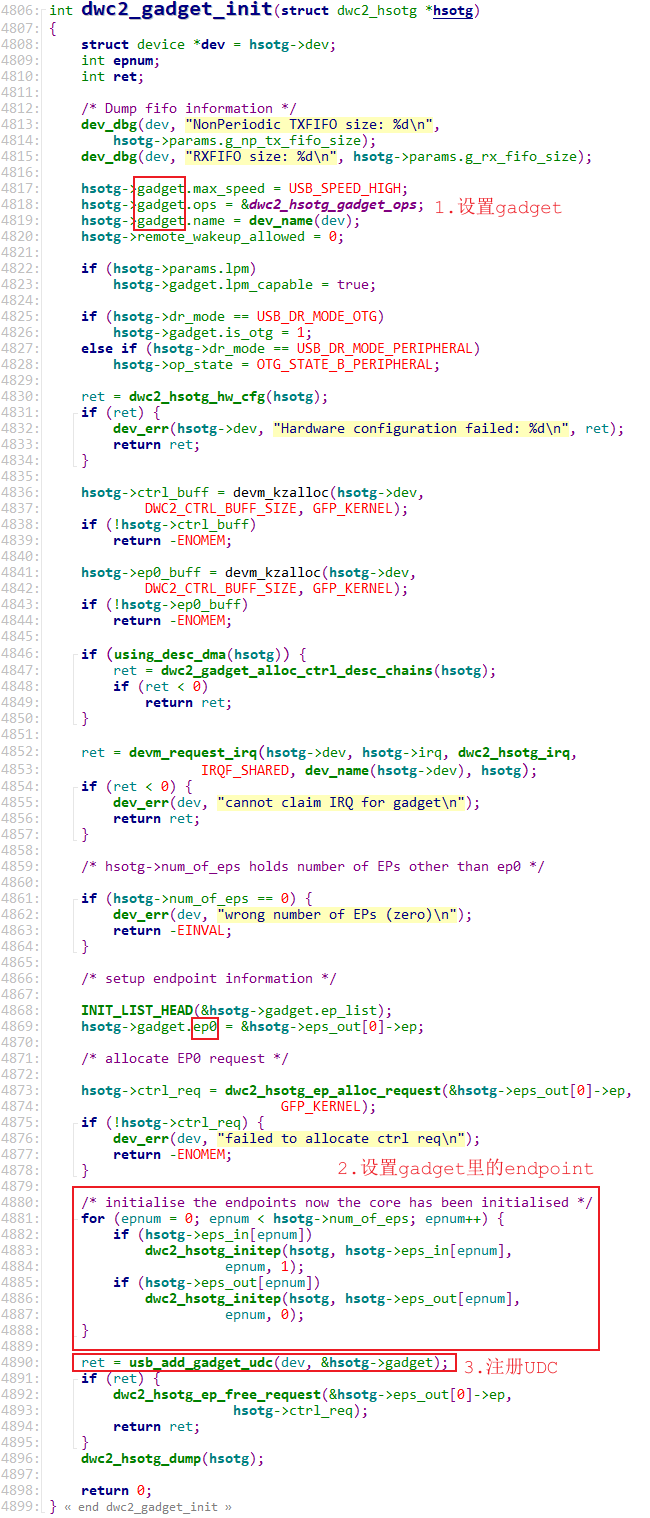

从硬件软件角度理解Gadget框架
描述
2. 从硬件软件角度理解 Gadget 框架
USB 传输的核心是 endpoint,使用 endpoint 可以收发数据。在 endpoint 之上,就可以模拟 USB 串口、USB 触碰屏、USB 摄像头。基于这个角度,Gadget 框架可以分为两层:
- 底层 endpoint 操作
- 上层模拟各类 USB 设备

2.1 底层硬件操作_UDC 驱动
不同平台采用的 USB 控制器型号不同,确认型号方法是从 dtb 反编译,找到包含 otg 字符的节点,在 Linux code 中搜索 dts 节点的 compatible,可以找到对应的 usb 从机控制器驱动。
对于底层 endpoint 的代码,需要从 UDC 驱动开始分析:
- IMX6ULL 的代码:
Linux-4.9.88driversusbchipideaci_hdrc_imx.c
ci_hdrc_imx_probe
ci_hdrc_add_device
pdev = platform_device_alloc("ci_hdrc", id);
// Linux-4.9.88driversusbchipideacore.c
static struct platform_driver ci_hdrc_driver = {
.probe = ci_hdrc_probe,
.remove = ci_hdrc_remove,
.driver = {
.name = "ci_hdrc",
.pm = &ci_pm_ops,
},
};
ci_hdrc_probe
ret = ci_hdrc_gadget_init(ci);
udc_start

- STM32MP157 的代码:
Linux-5.4driversusbdwc2platform.c
dwc2_driver_probe
retval = dwc2_gadget_init(hsotg);

2.2 上层软件操作
模拟各类 USB 设备时,软件怎么分层?以访问设备、获取描述符为例:
- Host 要分配地址、把地址发送给设备:不管要模拟什么设备,Gadget 都必须接收地址,这部分由 usb_gadget (硬件相关的驱动程序)实现
- Host 要读取各类描述符,这些描述符是由上层的驱动程序提供的
- 怎么把上层的描述符通过底层的 usb_gadget 传回给 Host?还需要一个中间层。Host 获取描述符时,方法是固定、通用的,这些方法可以由内核统一提供,这就是:usb_gadget_driver。
所以,从获取描述符的角度看看,上层软件至少分为 2 层:
- usb_gadget_driver:实现一些通用的 USB 访问方法,比如 Host 访问描述符时,由 usb_gadget_driver 提供
- 在这上面提供各类描述符,实际上,描述符的提供还可以分为两层:
- 设备描述符、配置描述符:由程序员决定,由 usb_composite_driver 提供
- 接口描述符、endpoint 描述符:由内核事先实现的、常用的 function driver 提供
软件层次可以进一步细化,如下图:

这涉及 2 个结构体:
- usb_composite_dev:它里面汇集有各类描述符、有一个 usb_funciton 链表(实现数据传输)
struct usb_composite_dev {
struct usb_gadget *gadget;
struct usb_request *req;
struct usb_request *os_desc_req;
struct usb_configuration *config;
/* OS String is a custom (yet popular) extension to the USB standard. */
u8 qw_sign[OS_STRING_QW_SIGN_LEN];
u8 b_vendor_code;
struct usb_configuration *os_desc_config;
unsigned int use_os_string:1;
/* private: */
/* internals */
unsigned int suspended:1;
struct usb_device_descriptor desc;
struct list_head configs;
struct list_head gstrings;
struct usb_composite_driver *driver;
u8 next_string_id;
char *def_manufacturer;
/* the gadget driver won't enable the data pullup
* while the deactivation count is nonzero.
*/
unsigned deactivations;
/* the composite driver won't complete the control transfer's
* data/status stages till delayed_status is zero.
*/
int delayed_status;
/* protects deactivations and delayed_status counts*/
spinlock_t lock;
/* public: */
unsigned int setup_pending:1;
unsigned int os_desc_pending:1;
};
- usb_udc:UDC 的本意是"usb device controller",usb_udc 结构体里面有 usb_gadget (表示 UDC 本身)、usb_gadget_driver()
struct usb_udc {
struct usb_gadget_driver *driver;
struct usb_gadget *gadget;
struct device dev;
struct list_head list;
bool vbus;
};
声明:本文内容及配图由入驻作者撰写或者入驻合作网站授权转载。文章观点仅代表作者本人,不代表电子发烧友网立场。文章及其配图仅供工程师学习之用,如有内容侵权或者其他违规问题,请联系本站处理。
举报投诉
-
USB Gadget serial应用实例(上)2023-07-13 5073
-
AMD Xilinx Linux 2022.1 USB Gadget使用2023-07-07 1269
-
从仿真器的角度理解Verilog语言12023-05-25 1485
-
从数字化实现的角度理解PI环节2021-08-30 2222
-
如何理解现场总线?从工业通信的角度看看资料下载2021-04-15 1561
-
应用于嵌入式系统软件和硬件接口问题的设计2018-11-01 3156
-
从硬件角度解析下这个USB Type-C2018-01-23 16174
-
字符设备驱动、设备驱动模型、sysfs、平台设备驱动的关系 -----从需求的角度去理解Linux之三2017-12-17 3172
-
从需求的角度去理解嵌入式Linux:总线、设备和驱动2017-12-11 2857
-
从需求的角度去理解Linux系列:总线、设备和驱动2016-03-11 4342
-
[分享]从Java的角度理解设计模式(连载)2009-06-19 2832
全部0条评论

快来发表一下你的评论吧 !

